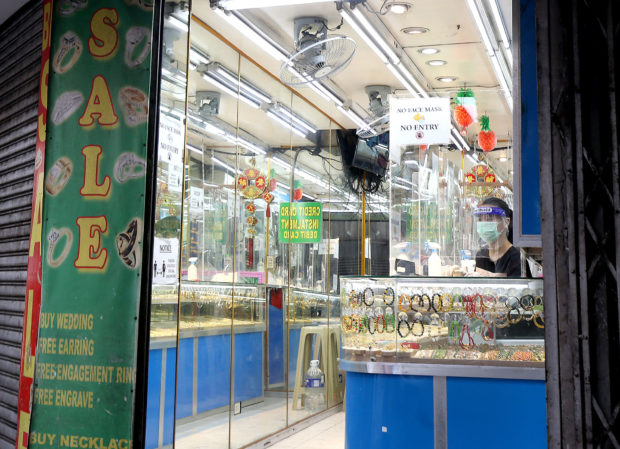
‘WHEN WILL PEOPLE START BUYING JEWELRY AGAIN?’ A jewelry store in Manila’s Chinatown opens on Sunday, about two weeks after Metro Manila returned to the less restrictive general community quarantine. —RICHARD A. REYES
MANILA, Philippines — Global gold prices are hitting all-time highs as pandemic-weary investors flock to “safe haven” assets. But in the Philippines, which has fallen into its deepest economic recession amid one of the longest and toughest lockdowns in the world, jewelry is fast losing its luster as a luxury commodity.
Jewelry sales have slid by around 80 percent since mid-March when the COVID-19 contagion prompted the quarantine of Metro Manila and other key regions, according to the estimate of Mia Florencio, president of the Guild of Philippine Jewellers, Inc.
“Personally, I am very apprehensive and scared, especially so at the start of the lockdown. In the hierarchy of things, when will people start buying jewelry again? People are saying that cash is king,” said Florencio, whose family owns T. Florencio Jewelry. She also owns Philippine Jewelry Institute and CMF Joia Inc.
The Guild of Philippine Jewellers, which consists of 65 mall-based jewelry shop owners in Metro Manila, has seen sales at only 15-20 percent of levels before the pandemic. This is true for stores that reopened when the metropolis was declared under general community quarantine.
Lockdown regulations for Metro Manila and surrounding regions were eased in June. Early this month, however, the government reimposed strict quarantine measures in an attempt to curb the surging contagion that has led to the Philippines’ unflattering record of having the highest number of COVID-19 cases in Southeast Asia.
Quarantine measures became less stringent starting Aug. 19.
Shifting priorities
But with Filipinos still barred from mass gatherings, many couples are postponing engagement parties and weddings and families and corporations are deferring celebrations, which typically perk up the jewelry industry.
Shopping malls, which host a number of jewelry shops, have lost the vibrant foot traffic they enjoyed for years.
And the lockdown has driven those with excess money and spare time to other asset classes like stocks, bonds, even art.
“The glitter of jewels and gold, a safe haven during a crisis, failed to attract investors given the pandemic. A new norm has also infected this industry: Consumers have shifted priorities in asset allocation,” said fund manager Astro del Castillo, managing director at First Grade Finance.
“The industry should aggressively shift to online [operations] to win back investors,” Del Castillo said.
Despite the slump in sales, however, jewelry shops have not slashed prices, unlike car dealers, as well as property developers selling yet-to-be-built condominium units and offering huge discounts and freebies to entice cautious consumers.
As established jewelers like Florencio pitch to clients that jewelry items are assets whose value appreciates when passed from one generation to the next, they keep their prices steady even when very few people are buying—and even when main input costs, particularly of gold, have been buoyant.
“Yes, money is hard, and yes, we need money to sustain our workers. You give them ‘ayuda ‘(assistance) as much as you can afford, but you have to temper it. How far can you go with [doles]? You also have to be ready once the economy is ready to start buying jewelry again,” Florencio said.
Hope in the holidays
At best, Florencio hopes that demand for jewelry will pick up by Christmastime.
But for now, the lockdown protocols spurred by the pandemic are exacerbating the challenges that jewelers like herself have faced in recent years: the decline of jewelry as a top-of-mind luxury item, stiff antimoney laundering and tax regulations, and competition from smugglers and underground vendors who can easily slash prices now just to move their inventory.
Before COVID-19, people had also begun to spend more on travel and tourism and less on jewelry. But even if the pandemic has bludgeoned travel and tourism, it has not diverted more of people’s discretionary funds to jewelry.
Said Florencio: “How do you reposition yourself? Do you change your product lines and come out with cheaper goods?”
To make jewelry more affordable to a broader market amid the soaring prices of gold, jewelry makers have started developing less expensive items in the last five to seven years. They are now selling more 14-karat instead of 18-karat gold jewelry.
Some jewelers have started using more and more silver instead of gold, and those previously using silver have downgraded into producing jewelry made of copper or other metals.
In Florencio’s reckoning, this pandemic will shake up the jewelry landscape, possibly weeding out the small players that comprise 90 percent of the industry.
It’s survival of the fittest, she said: “Just as in any other industry, ngayon, matira matibay.” INQ